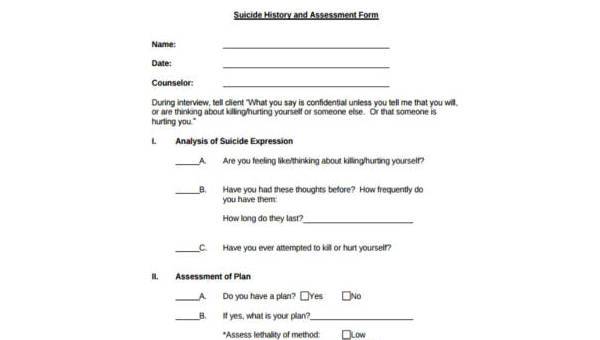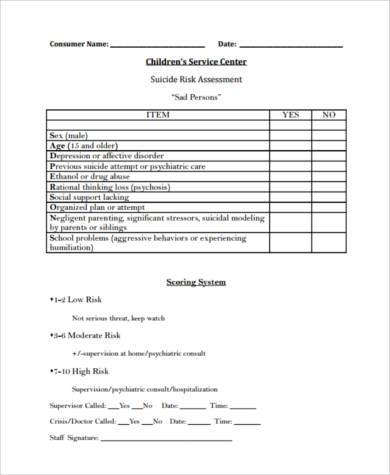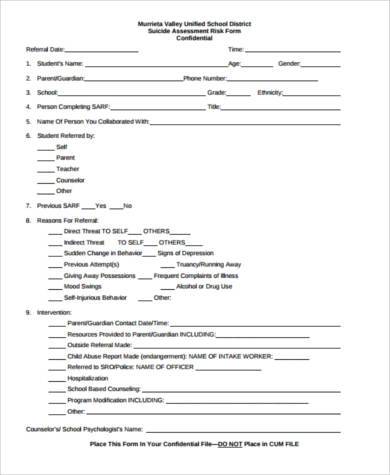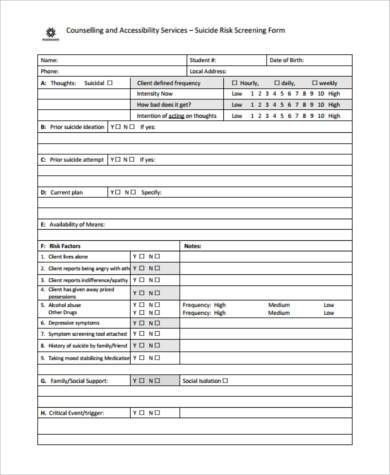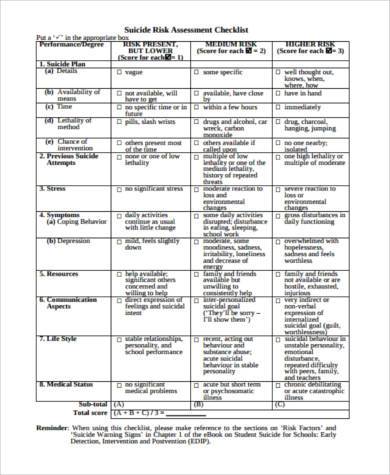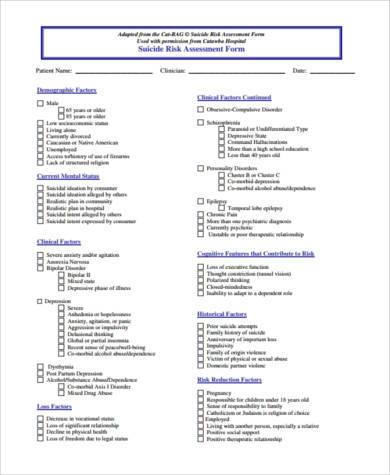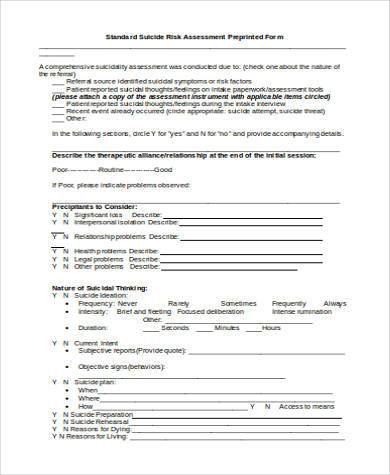Suicide is the third leading cause of death in the world and the 11th in the United States. An average of 100,000 people commit suicide each year, making the issue a grave and serious one. In lieu of these statistics, evaluating an individual for suicidal tendencies is critical in order to prevent self-annihilation and provide proper help and guidance.
Suicide is found to be more common among men than in women. By conducting a Suicide Risk Assessment, experts and clinical personnel will be able to determine the ability of a person to potentially hurt himself or cause his own death.
Children’s Suicide Assessment Form
Suicide Risk Assessment Form
Suicide Assessment Form for Students
Suicide Assessment Form in PDF
A Suicide Risk Assessment is a process that allows clinicians to provide an estimate of a person’s probability to commit suicide. An assessment is usually done with the aid of an Assessment Form, Self Assessment Forms, or Health Assessment Forms.
The evaluation bases its results on various factors that could lead to the decision of committing suicide. These include varying forms of psychological disorders, substance misuse, stress, genetics, family history, or culture and social elements.
Psychological Disorders
Psychological disorders may be one of the causes that could lead a person to commit suicide. Mental disorders such as depression, schizophrenia, and bipolar disorder are usually linked to individuals with suicidal tendencies, although depression is considered to be the second most common cause of disability.
Depression is when an individual feels severe despondency and dejection. According to the World Health Organization, depression has rapidly increased its effect in over 100 million people in the last year and is one of the top psychological disorders that exhibits suicidal tendencies in a person.
Substance Abuse
Drug and alcohol abuse are the second leading causes of suicidal tendencies. Studies show that a lot of individuals who had been addicted to drugs or were alcoholics admit to having attempted suicide or inflicted harm on themselves; however, these people are at least 5 to 6 times more likely to report a suicide attempt than those who aren’t.
Hereditary
Suicidal tendencies can also be a side-effect of inheriting mental illness, particularly the disorders that increase the risk of suicidal thoughts such as depression, schizophrenia, and bipolar disorder. This can again be linked to the first factor: Psychological Disorder.
A new study from the Center for Addiction and Mental Health has found evidence of a gene variation that is connected with suicidal tendencies, which supports this factor as a cause of inhibiting suicidal tendencies due to genetics.
Suicide Assessment Checklist for Schools
Suicide History and Assessment Form Example
Generic Suicide Assessment Form
Suicide Assessment Form in Word Format
Social, Cultural, and Economic Factors
About 4,000 people who are as young as 15 and as old as 34 commit suicide. Apart from mental disorders, substance abuse, and genetics, suicidal behavior may also be instigated by social, cultural, and economic causes.
Family history, violence, physical or sexual abuse, and exposure to suicidal behavior may also be other causes that could lead a person to commit suicide.
Finding out if a person has suicidal tendencies is not exactly a complicated thing to assess. People with suicidal tendencies usually exhibit warning signs such as:
- Someone who constantly threatens to harm himself
- A person who always talks or thinks about death
- Calling or visiting people to say goodbye
- Losing interest in things one used to be interested in
- Feeling of hopelessness
- Constant rage or anger
- Dramatic mood changes
- Lacking of purpose to live
- Recklessness
- Trouble sleeping and eating
Preventing suicide may not be as easy as it sounds. A suicide assessment is one of the best ways to prevent further suicidal behavior or any attempt to inflict harm on one’s self. If you feel that someone might be suicidal, ask them directly – some people who tend to be suicidal are usually just waiting for less judgement and more understanding.
Related Posts
-
How to Conduct a Risk Assessment? [ With Samples ]
-
FREE 4+ Sample Child Assessment Forms in MS Word | PDF
-
FREE 11+ Sample Financial Assessment Forms in PDF | MS Word | Excel
-
FREE 7+ Sample Health and Safety Risk Assessment Forms in PDF | MS Word
-
FREE 8+ Sample Supplier Assessment Forms in PDF | MS Word
-
FREE 7+ Sample Caries Risk Assessment Forms in PDF | MS Word
-
FREE 7+ Sample Management Risk Assessment Forms in PDF | MS Word
-
FREE 7+ Sample Infection Control Assessment Forms in PDF | MS Word
-
FREE 8+ Income Assessment Form Samples in PDF | MS Word
-
FREE 8+ Education Assessment Form Samples in PDF | MS Word
-
FREE 22+ Sample Self-Assessment Forms in PDF | MS Word | Excel
-
FREE 8+ Job Assessment Form Samples in PDF | MS Word
-
FREE 7+ Suicide Risk Assessment Forms in PDF | MS Word
-
Physical Therapy Assessment Form
-
FREE 11+ Assessment Forms for Teachers in PDF | Ms Word | Excel
